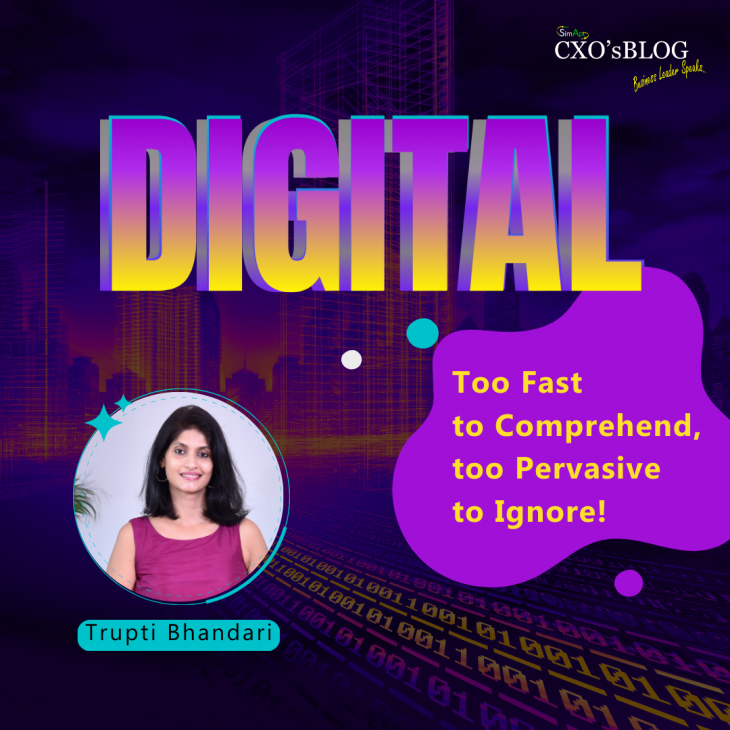Author: Trupti Bhandari
“Boss, we will understand the data signals, optimize our search, do some data management, integrate Al, set an evaluation metric…’ a young trainee exults as | look on, wondering whether he can connect the dots.
In another context, | hear a colleague say, ‘Digital marketing will either outdated us or recast us: At a CMO meet recently, we nodded our heads in sombre agreement. ‘If we can synthesize classical marketing with the newly emerging tools of digital, we will lead the change, if not…’
“We will be led, the others echo.
As we see the digital reality unfold, we have felt two contrasting tugs. One towards the exciting new world marked by new technology, and another that confuses managers as they struggle to reconcile digital marketing ways with classical marketing that they have grown with. It’s like putting a square peg into around hole.
That’s what digital is like: too fast for anyone to comprehend in its entirety, yet too intrusive and pervasive to be ignored.

Digital Disruption
Earlier, we consumed TV alongside some radio news and magazines. Now, we incessantly gaze at our mobile screens, and this isn’t just the urban consumer anymore. Breakfast is had with WhatsApp ‘good morning’ greetings – the only one of its kind – with spiritual admonitions and work or college hours are dotted with frequent visits to Facebook, Instagram or Twitter. During long commutes, we snack on YouTube videos, and after a brief interruption for dinner, we start swiping at the screen for online shopping, in between Amazon Prime and Netflix shows. This is the hugely transformed consumer’s life and marketers have to shadow this digital overreach.
For a while now, digital strategy has been the residue of mainstream strategy. When the advertising brief is written and executed, and media monies saturated on TV, the leftover money is allocated for digital presence. However, we need to repurpose our strategy by considering the consumer realities, as given below:
Consumers aren’t anonymous anymore.
‘We need to wake up to their strong digital identities. They interact with brands and often want to be in the driver’s shoes.
Consumers are seeing deeper and further, worldwide.
Not only is this raising their expectations but also their frustration if/when products fail. With a rise in e-commerce, ordering globally may not be so distant. Empowerment of consumers is happening at a blistering pace.
Information is gathered in seconds and opinions dart around in nanoseconds. Doctors have to contend with global experts while Ola and Uber have to constantly submit to the tyranny of user experience. Brand loyalty is now the result of the last experience and is not built on the habit of quiet brand usage.
Consumers are demanding.
Passive consumption is becoming a thing of the past as consumption activism rises. ‘What’s special for me?’, What’s the promotion here versus somewhere else? ‘What ales am | getting? How are you making my life choices better than your competitor? and even, ‘How are you helping me get more out of life, improve my health, express myself better, get fame and money?’ Brands that delight has to pander to all this and still surprise with more.
Reactions take place in real-time.
Irate consumers can whip up a storm through a mere tweet with a few characters, or horrify with a graphic on Instagram. No algorithm can predict how viral it becomes and how it spins out of control. You can’t do an ABC analysis of consumer response and fe a satisfactory A have to be customized and provided instantly.
‘Consumers are also cross-connecting with communities around the world, asking questions that were otherwise kept in remote files of CSR. Information can’t be closeted if it concerns the consumer – they decide what concerns them.
‘Welcome to the age of consumer tyranny or consumer celebration. Which side you are on is determined by how you view digital. Before the consumer turns indifferent or hostile towards a brand, they must be integrated with a full-blown digital strategy.
The first problem with digital is the jargon, which confounds us completely. However, can it be seen as the old world, only clothed in new garments — differing in some respects but fundamentally behaving like the old one, familiar to most marketers A closer look unfolds more opportunities than confusion.
This is an excerpt from the book Pragmarketism – Pragmatic ing insights for winning Indian authored by Trupti Bhandari and Arvind Bhandari. The book it iani: igitalism and pragmatism to win with the digitally evolving ‘desi’ consumers.
Reproduced with permission from Harper Collins.
